As Hispanic Heritage Month comes to a close, we wanted to take time to celebrate our own No Kid Hungry Texas team and learn more about how they celebrate their Latino/a/x heritage and what being Hispanic means to them.
Para leer el blog en español, haga clic aquí.
Franco Cruz, Senior Program Manager
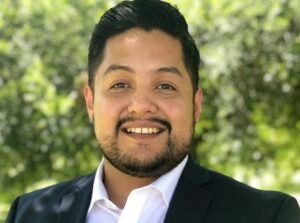 Franco is a first-generation Mexican American and English language learner. He grew up in El Paso where he met his wife Nancy – they have been married for 13 years and currently reside in San Antonio with their 3-year-old son and 1-year-old daughter. Franco is proud of his Mexican food traditions because they have been passed on from multiple generations. Nearly every Sunday, his family gets together for a large meal and split up the cooking duties – sometimes they will throw some arrachera, or skirt steak, on the grill while some family members will make fresh tortillas in the kitchen. Other times, the whole family will focus their efforts on making chile rellenos or mole. Of course, they love inviting friends to join – as long as they bring the beer!
Franco is a first-generation Mexican American and English language learner. He grew up in El Paso where he met his wife Nancy – they have been married for 13 years and currently reside in San Antonio with their 3-year-old son and 1-year-old daughter. Franco is proud of his Mexican food traditions because they have been passed on from multiple generations. Nearly every Sunday, his family gets together for a large meal and split up the cooking duties – sometimes they will throw some arrachera, or skirt steak, on the grill while some family members will make fresh tortillas in the kitchen. Other times, the whole family will focus their efforts on making chile rellenos or mole. Of course, they love inviting friends to join – as long as they bring the beer!
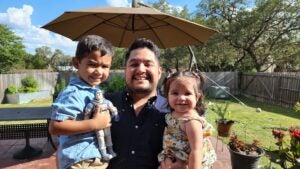 Franco hopes that folks understand that Hispanic/Latino culture is vast and spans many countries. “I have friends from Venezuela, Colombia, Nicaragua, and Honduras, and we all constantly point out both the many similarities and also differences in our language and customs. Many Spanish words can have different meanings in other Hispanic/Latin countries- sometimes those meanings can be inappropriate or cause an unintentional insult. As a Mexican American in a major city, it has been great to learn the nuances of our language through friends from other Hispanic/Latino countries.” Franco shared that his friends are often misidentified as Mexican by many Texans and across the US, yet they still strive to represent their own culture and customs because they often differ so much from those in Mexico. “I think more Hispanic/Latino representation is needed in the media that highlights the diversity between Hispanic/Latino countries that span across North and South America.” Read more about Franco’s story.
Franco hopes that folks understand that Hispanic/Latino culture is vast and spans many countries. “I have friends from Venezuela, Colombia, Nicaragua, and Honduras, and we all constantly point out both the many similarities and also differences in our language and customs. Many Spanish words can have different meanings in other Hispanic/Latin countries- sometimes those meanings can be inappropriate or cause an unintentional insult. As a Mexican American in a major city, it has been great to learn the nuances of our language through friends from other Hispanic/Latino countries.” Franco shared that his friends are often misidentified as Mexican by many Texans and across the US, yet they still strive to represent their own culture and customs because they often differ so much from those in Mexico. “I think more Hispanic/Latino representation is needed in the media that highlights the diversity between Hispanic/Latino countries that span across North and South America.” Read more about Franco’s story.
Mia Medina, Program Manager
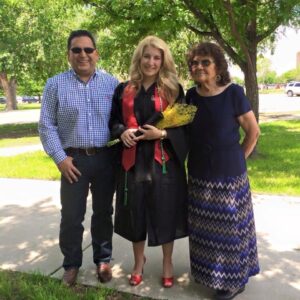 Mia identifies both as Latina and half Mexican American and when she thinks about being proud of her heritage, she thinks about her grandmother Delia. Her grandmother lived next door and often picked her up from school and took care of her when her parents were working. Delia taught her about her heritage, taught Mia how to speak Spanish, and of course introduced her to Selena (on cassette tape!).
Mia identifies both as Latina and half Mexican American and when she thinks about being proud of her heritage, she thinks about her grandmother Delia. Her grandmother lived next door and often picked her up from school and took care of her when her parents were working. Delia taught her about her heritage, taught Mia how to speak Spanish, and of course introduced her to Selena (on cassette tape!).
 For Mia, being Latina is about appreciating your heritage and everyone who has come before you. She has been deeply impacted by her grandmother and her resiliency and her dad who taught her the importance of serving your community. Mia also shared that “being Latina looks different for everyone, and for me, I’m on a journey to continue to learn more about my heritage and culture and finding ways to partake in traditions that honor my culture.” She does this by practicing pottery, relearning Spanish, and even hearing the stories of her Latino family and community members.
For Mia, being Latina is about appreciating your heritage and everyone who has come before you. She has been deeply impacted by her grandmother and her resiliency and her dad who taught her the importance of serving your community. Mia also shared that “being Latina looks different for everyone, and for me, I’m on a journey to continue to learn more about my heritage and culture and finding ways to partake in traditions that honor my culture.” She does this by practicing pottery, relearning Spanish, and even hearing the stories of her Latino family and community members.
She also hopes that others feel empowered to explore their heritage and culture too, sharing that “… It’s okay to explore, rediscover and reclaim your culture at any age. I think for many of us who are mixed race, you can hold onto complex feelings about what it means to belong. But having different experiences than your friends or family doesn’t make you any less Latina. We are unique and the journey of self-discovery through history, tradition,and art is a beautiful thing that will look different for every person.”
Teresa Contreras- O’Reilly, Program Associate
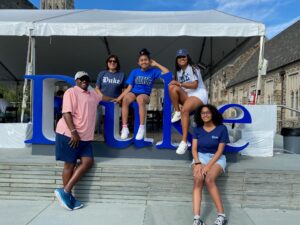 Teresa was born and raised in Austin and has two younger sisters. Her mom is from South Texas and identifies as Mexican while her dad is from St. Croix and identifies as Caribbean. For Teresa, being Afro-Latina means playing chalupa, or Mexican bingo, for hours with her tias, making hundreds of tamales with her mom and sisters during Christmas time, preparing buñuelos on New Years Eve, and visiting family in
Teresa was born and raised in Austin and has two younger sisters. Her mom is from South Texas and identifies as Mexican while her dad is from St. Croix and identifies as Caribbean. For Teresa, being Afro-Latina means playing chalupa, or Mexican bingo, for hours with her tias, making hundreds of tamales with her mom and sisters during Christmas time, preparing buñuelos on New Years Eve, and visiting family in 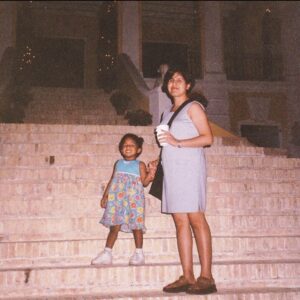 St. Croix. It also means hearing stories of hardship – her mom, her 11 brothers and sisters, and her parents endured as migrant farmers. Her family migrated from South Texas to the Midwest every summer beginning in the 1920s, when her grandpa was a young child. This lasted until 1985 when her mom was 17.
St. Croix. It also means hearing stories of hardship – her mom, her 11 brothers and sisters, and her parents endured as migrant farmers. Her family migrated from South Texas to the Midwest every summer beginning in the 1920s, when her grandpa was a young child. This lasted until 1985 when her mom was 17.
Teresa would like people to understand that Latinos are not a monolith, and not every Latino knows how to speak Spanish. Many Latino parents likely faced discrimination and segregation because of their Hispanic identity. Sadly, that resulted in repressing their own culture and not passing down the Spanish language in order to protect future generations.
Teresa hopes that every Latino takes time to embrace their culture and their authentic selves.. “Don’t let other people’s negative stereotypes about Latinos stop you from embracing and celebrating your culture. There is no one Hispanic ‘look’ or ‘way of being.’ We are all unique, look different, and carry various identities. Learn to love who you are and don’t let anyone tell you who you should be.”
Stacie Sanchez Hare, Director
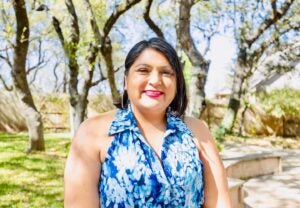 Stacie was born and raised in San Antonio where she now resides with her husband and son. Her parents both identify as Mexican American, and her mom grew up in the Rio Grande Valley. The Sanchez side of her family is from the west side of San Antonio. Stacie loved growing up in a place where her food and culture were routinely celebrated through events like Fiesta with parades, parties and festivals for three weeks. Tejano music is played at Fiesta and cascarones (eggs-filled with confetti) are cracked over the heads of unsuspecting partygoers.
Stacie was born and raised in San Antonio where she now resides with her husband and son. Her parents both identify as Mexican American, and her mom grew up in the Rio Grande Valley. The Sanchez side of her family is from the west side of San Antonio. Stacie loved growing up in a place where her food and culture were routinely celebrated through events like Fiesta with parades, parties and festivals for three weeks. Tejano music is played at Fiesta and cascarones (eggs-filled with confetti) are cracked over the heads of unsuspecting partygoers. 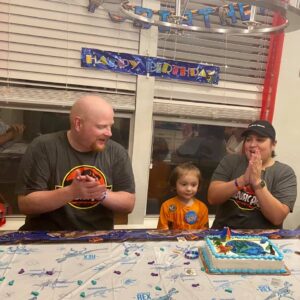 Stacie identifies as a proud Chicana and sees the world through the lens of race. She and her brother recently did a DNA test and learned that they are both 46% Indigenous to North Mexico and she has been exploring the often-suppressed connective tissue between Mexican and Native. Since the launch of the previous administration, she has felt an increased sense of urgency to show up in the world as Mexican and a person of the global majority. Most of the representation she sees of people who look like her are mostly playing roles of drug dealers, gang members, teen moms and domestic servants. She often wishes that people understood that Latinos are not a monolith in terms of voting or values.
Stacie identifies as a proud Chicana and sees the world through the lens of race. She and her brother recently did a DNA test and learned that they are both 46% Indigenous to North Mexico and she has been exploring the often-suppressed connective tissue between Mexican and Native. Since the launch of the previous administration, she has felt an increased sense of urgency to show up in the world as Mexican and a person of the global majority. Most of the representation she sees of people who look like her are mostly playing roles of drug dealers, gang members, teen moms and domestic servants. She often wishes that people understood that Latinos are not a monolith in terms of voting or values.
She has worked with intentionality to center her identity in her work and in her personal life. Stacie shared “It isn’t easy being a person of color or woman in this country. Whiteness is centered in almost every industry and aspect of our culture, and it can feel futile to find your place in all of it. We need representation, mentorship, and social capital to survive. Do the work of learning about different cultures and be thoughtful about your allyship—try standing beside or behind a person of color, and make room for them at the table as an equal.”



